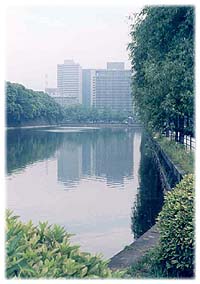
| Intro | Speech contest | Pizza delivery | Osechi foods | Gallery show | Marble house | Kamakura | Bonenkai | Bonenkai 2 | Emperor | Sapporo | Walking | Hanami | Visitors | Skiing | 7 Lucky gods | Visitor's survival guide | Kasuga |
walking to work
June 1999
 Living in Tokyo, you might think that there's no
opportunity to commune with nature. But every morning and evening, I take a
stroll through Hibiya Park and past the Imperial Palace outer moat on my way to
and from work.
Living in Tokyo, you might think that there's no
opportunity to commune with nature. But every morning and evening, I take a
stroll through Hibiya Park and past the Imperial Palace outer moat on my way to
and from work.
When I'm feeling lazy, I can catch a subway train in the basement of my office building, ride four stops and to transfer to another line and reach home. Sometimes I do that. All winter I did. But when the weather turned nice, I started walking the first four stops above ground and then catching the train in the station where I'd normally transfer.
It's a lovely walk. In the morning, I exit the subway station into the sunlight and fresh air. The park is wooded with huge ginkos, pines, maples, chestnuts and sycamores. There are clearings with ponds and fountains. Restaurants dot the park which is the size of two city blocks.
 A large, English rose garden with palm trees
in the centre is a focal point for cats and pigeons and the people who like to
feed them. There is a playground with really fun equipment and there's even a
library. Along the paved and paths are sculptures and weathered monuments.
Flowering shrubs provide color along the borders of the park.
A large, English rose garden with palm trees
in the centre is a focal point for cats and pigeons and the people who like to
feed them. There is a playground with really fun equipment and there's even a
library. Along the paved and paths are sculptures and weathered monuments.
Flowering shrubs provide color along the borders of the park.
After the park, I cross the street and walk along the Outer Moat of the Imperial Palace. The moat runs for about six blocks, broken at regular intervals by streets running from the palace toward Tokyo Station. It's not much of a defensive moat anymore.
There are carp in the moat. Huge grey fish with fins that break the surface of the water and mouths that open into the air to accept whatever is floating on water. Smaller, brightly colored carp in shades of white and gold. Turtles live there, too.
The first section of the moat is home to a black swan; the second section is shared by two white swans. The final section has no fowl denizens but it does have a beautiful curved bridge made of stone.
 There is always something new to see as I walk along the moat. Last week, I
saw my first dragonflies of the summer-big black bodied, double winged flyers
with white stripes on their bellies. I've seen heron and cranes stopping over for
a snack. One morning a crow spoke to me. A beautiful iridescent blue and brown
bird with beady eyes sat on the railing under a willow and let me watch it from a
short distance away. Two small, chalk colored sea birds dive bombed the moat for
breakfast one morning.
There is always something new to see as I walk along the moat. Last week, I
saw my first dragonflies of the summer-big black bodied, double winged flyers
with white stripes on their bellies. I've seen heron and cranes stopping over for
a snack. One morning a crow spoke to me. A beautiful iridescent blue and brown
bird with beady eyes sat on the railing under a willow and let me watch it from a
short distance away. Two small, chalk colored sea birds dive bombed the moat for
breakfast one morning.
If I time my walk right, I can watch the man who feeds the swans. He lowers down a bin full of grain to them every day. The pigeons and sparrows enjoy this event as much as the swans do.
At the end of the moat is a police box, a koban, where a policeman is stationed for a year. The police assigned to these neighborhood stations are called Omawari-san, "Mr. Walk-Around," and they are a fixture of almost every major intersection in Tokyo.
In the evenings as I walk from the office back toward the park, I see Tokyo Tower lighted a rosy red by the setting sun or glowing with its own lights in the dark of evening. Getting into the sterile confines of the subway station after the park is always disappointing. If home weren't so far away, I might walk the whole way.